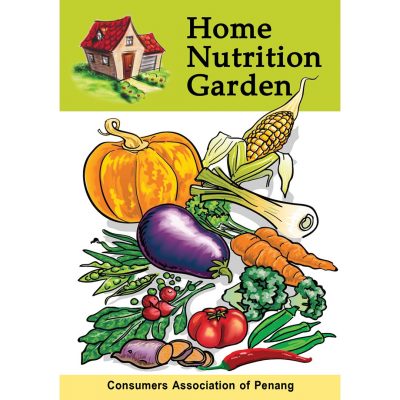An idea which can change the dismal story of today’s healthcare…the message going out today is let food be your medicine and medicine your food. But your food must be organic, nutritious and
By Pankajbala R Patel
The Consumers Association of Penang in Malaysia has for years been bringing out some very useful series of publications to educate, inform and teach readers and the lay public how to reap the genuine good life for themselves and their family and friends! Amongst the very useful booklets “Home Nutrition Garden” which is full of timeless insight into why we should put in our mouth food which nourishes and blesses Mother Earth.
In his Preface CAP President SM Mohamed Idris observes, “Home gardening has been part of our tradition. Two or three decades ago each and every house was adorned with vegetable gardens. Fresh vegetables were used in cooking. Needless to say, these vegetables were healthy and abundant with nutrition.” But gone are those days of old and sighs Mohamed Idris, planting, gardening, farming have become unfamiliar to the younger generation.
But perhaps the times have a turn for the better anew! We, the consumers, are daily becoming conscious that the fresh produce which reaches our tables from the world over is not food but mostly hype and bad food with chemicals in the form of fertilizers, pesticides and herbicides and much more…we see vegetables which are usually sprayed, dipped, drenched and coated with chemicals so that they look more beautiful and enjoy a longer shelf life.
Pertinently, Idris points out, “If we start growing our own vegetables, we could relish pesticide free healthy vegetables. Not only those with houses with land, but apartment dwellers too can grow vegetables provided that they equip themselves with some basic information on planting and farming.” Hence, we take pleasure in reproducing some interesting step-by-step information and illustration to get you going on becoming self-sufficient at least when it comes to vegetables and fruit!
The booklet is such a fund of useful information that we take the liberty of offering it here for those who have a yen to start their own “home nutrition garden” for health and happiness. Make sure you use no chemical fertilizers and pesticides to eat you own nutritious and full of life-giving health in your efforts to grow an honest garden of food!
Excerpted from `Home Nutrition Garden’ published by the Consumers Association of Penang, Malaysia
WHY DO WE NEED HOME NUTRITION GARDEN?
- We can enjoy fresh and health vegetables from our own garden.
- Can have our meals with the relief that these vegetables are free from toxic chemicals.
- We could save our money.
- We can prevent environmental pollution.
- Organic kitchen waste and garden waste produced at home can be recycled properly and utilised.
- Home gardening is one way of exercising our body.
Do you need training to set your own home garden?
- Not necessary. Your mere interest in gardening is of utmost importance. Care and passion towards plants is sufficient.
- Not only houses with land, but hose living in apartments too can create their home garden.
- SOIL HEALTH
In home garden, prime attention should be given to soil health. Compost materials leaves, grass) help in soil fertility. Organic matter input is vital for the growth of healthy vegetables. When the soil is healthy, plant disease and pest attacks are under control.
- PREPARING COMPOST
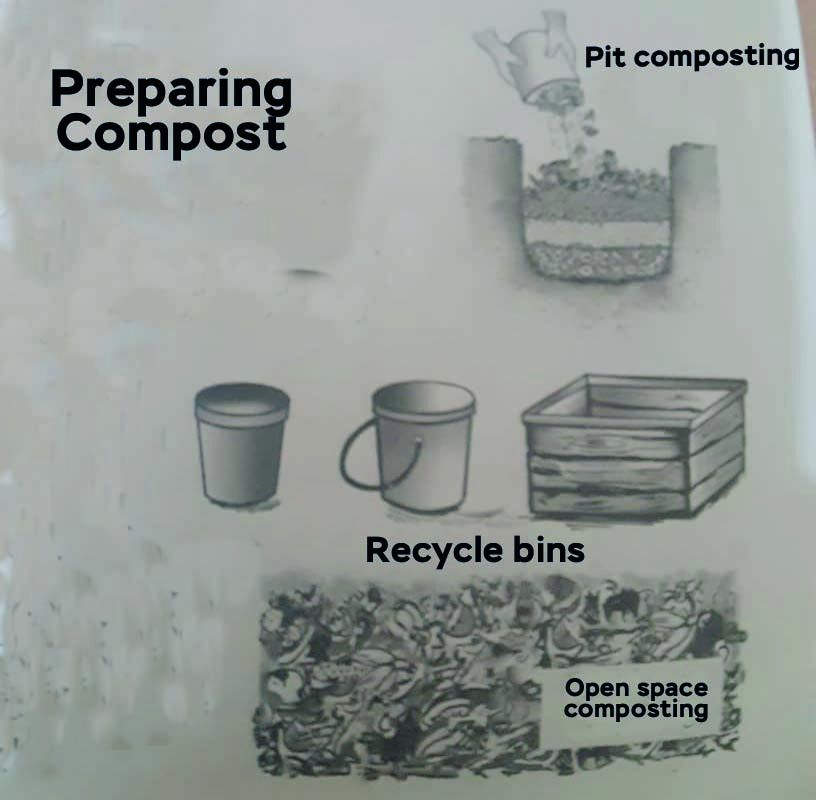
Various methods can be applied in compost preparation:
- Pit method
Dig a pit and dump organic waste into it.
- Bin method
Use unwanted bins and collect the waste to compost.
- Open method
Composting can also be done in open space above ground.
Points to notice when composting
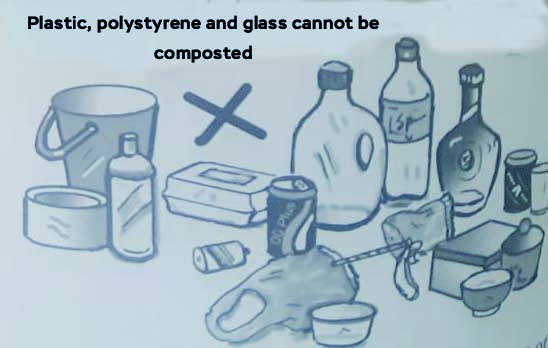
- Beginners can start composting by collecting uncooked vegetables, vegetable peels, and fruit waste from kitchen; leaves, seeds and grass from garden. Avoid citrus fruits such as lime, lemon and oranges in the initial days of composting.
- Meat and cooked waste can also be composted. But it has to be maintained well so as not to attract flies and pests.
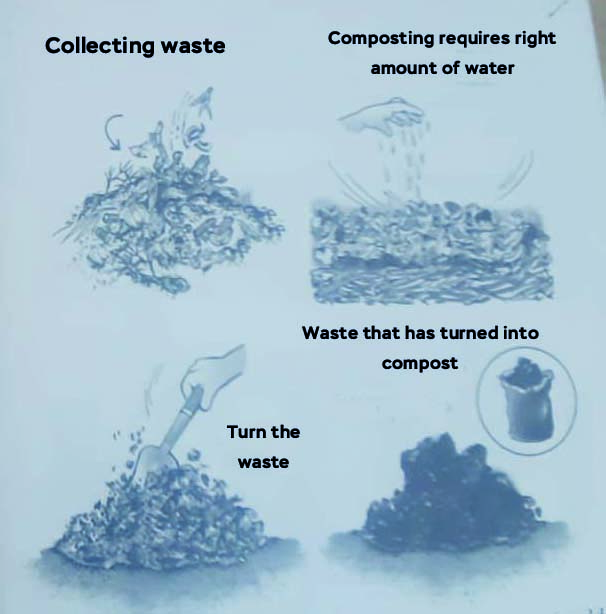
- Plastics, polystyrene and glass cannot be composted.
- Water is vital for composting process. But too much of water can rot the organic material. Hence, it is important to maintain the right moisture in your waste. It should not be soggy at any point.
- Turn waste occasionally for aeration.
- Proper composting releases heat. If seeds are sown while the compost is still hot, the seed loses its germinating capacity. Hence, seeds should be sown when there is no more heat in the pile.
- When composting is done in a bin, whenever wastes are added to the bin, some garden soil may be spread on it. Newspaper or plain paper can also be used for this purpose. This ensures absorption of extra moisture from the waste. This method prevents rotting of the waste
Pit composting
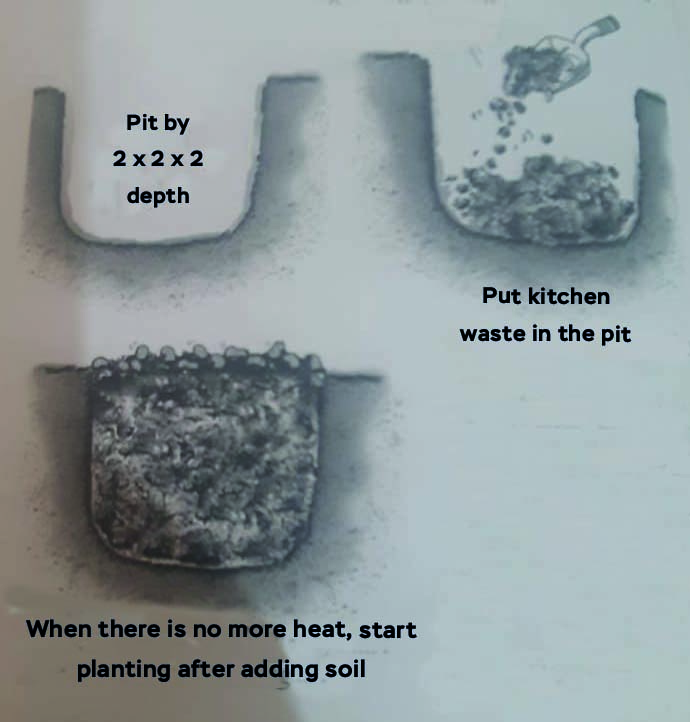
- Dig a pit 2x2x2 feet.
- Dump your kitchen and garden waste into this pit. Once a week sprinkle water and turn the waste. In between add some soil to the waste.
- When the pit is about three-quarter full, put a stick, leave for few minutes, take it out and feel it to check the temperature.
- When it is confirmed there is no more heat, spread some garden soil on it and plant vegetables.
Composting in a bin
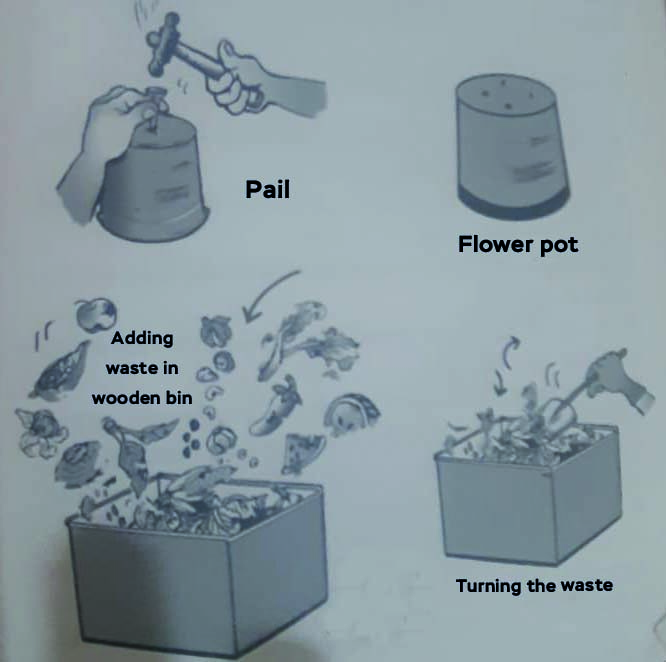
- Old pail, pot, plastic containers, wooden racks can be used as composting bins.
- Make holes at the base of the container for excess water to flow.
- Fill the base with gravel as the first layer, followed by sand and garden soil. Each layer should be about 1 inch height. After that, start adding waste into this.
- Small amount of soil can be added on to the waste once in a while. Sprinkle water to maintain moisture and turn the waste once a week. Waste will get composted in about 30 days. Take one handful of this compost and apply to plant.
- Prepare two such bins. When the first one is full, can start putting waste in the second bin.
Open space composting
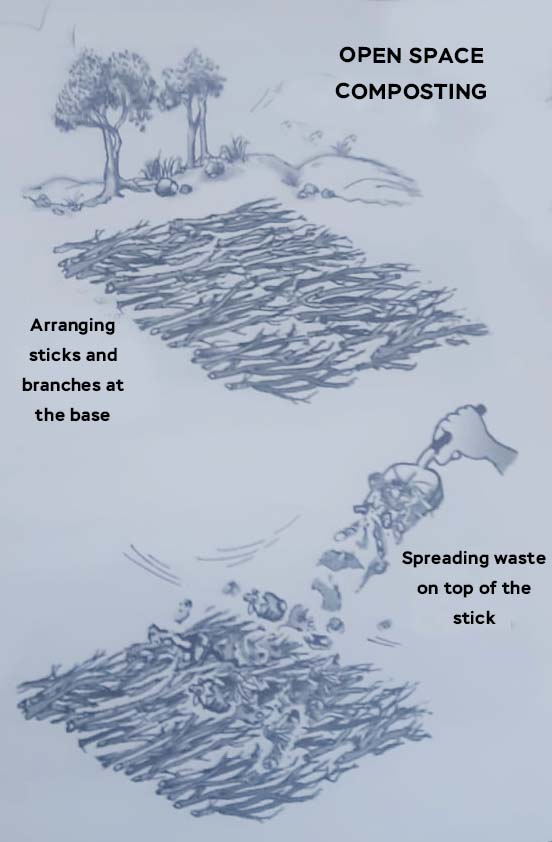
- This method is appropriate for those producing kitchen and garden waste in large scale.
- Select an area where rain water does not collect and mark a spot measuring 4×4 feet.
- Arrange small sticks and branches at the base of the market spot.
- On top of the sticks spread kitchen and garden waste up to one foot height.
- When the waste reaches about one foot height, dilute some cow dung with water and sprinkle on the waste. If cow dung is not available, add some water in sour curd and sprinkle.
- After sprinkling, spread the waste again for another one foot height. Then sprinkle with diluted cow dung or curd. Repeat this until you spread the waste up to 4 feet. Remember to sprinkle water for each 1 foot of waste.
- When the waste pile reaches 4 feet height, sprinkle water until the heap gets drenched.
- Loosely cover the waste with a plastic sheet.
- Once in 4 to 5 days open the plastic sheet and sprinkle water to the heap.
- Turn the waste once in every 10 days. Turning should be done thoroughly.
- Compost is ready within one-and-half month to 2 months.
Growth promoters preparation methods
Apart from composting, we can prepare simple growth promoters for our plants. Do not use metal container in this preparation. Preparation methods are as follows:-
Fish Amino Acid
Fish waste 2 handful
Molasses or brown sugar 2 handful
Mix fish waste and molasses together in a container. Cover the mouth of the container with cotton cloth. Stir this mixture once a day. Use wooden spoon or stick to mix. After stirring, cover it again with cotton cloth. If you feel it inconvenient to open and close the pot every day, just lift the pot and swirl it well in both directions (clockwise and anti-clockwise) about five times in each direction and leave. Keep stirring or swirling every day. On the 10th day a thick liquid will be formed. Strain this liquid and keep it in a bottle. Once tablespoon of this liquid should be mixed with 1 litre of water and sprayed to your plant. (Preferably use hand sprayer). This liquid can be stored for six months. Fish amino acid can be sprayed to plant twice a week.
Coconut lassie for flowering
Coconut milk 100ml
Lassie 250ml
Water 150ml
Mix coconut milk, lassie and water together in a container. Close the container with cotton cloth. Stir this mixture once a day. Kep this mixture fo 15 days. On the 16th day coconut lassie is ready. Tis mixture can be used for 3months. Add 10 times more water to the amount of coconut lassie and spray to plants. It helps in flowering of the plants.
To prepare lassie put curd (homemade yogurt is called curd) in the blender and stir two or three times. Remove the butter that surfaces. The remaining liquid without butter is lassie.
Farmers EM
Pumpkin 1 slice
Papaya 1 slice
Banana 2
Molasses 200 gram
Egg 1
Water 2 litres
Take 200grams each of the above mentioned fruit. Cut the fruits into small pieces, put in a container and add 2 litres of water. Break an egg into this and stir thoroughly. Put this blended mixture into an airtight container. On the 10th day, strain the solution. Add 3 tablespoons of FEM into 2 litres of water, stir and pour on the soil. This solution can also be sprayed to the plants. It develops good microorganisms in the soil. The residue after straining can be added into compost bin or to the soil.
- PLANTING METHODS
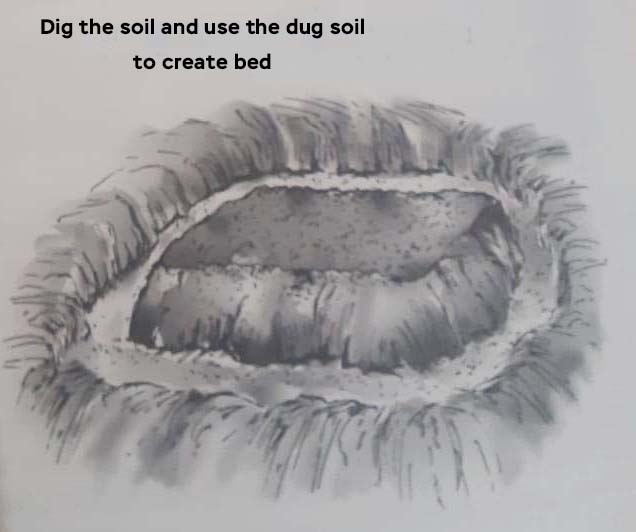
- The width of the bed should be from 1 to 3 feet. The length can be from 5 to 10 feet. It should be manageable. The length and width can be decided by looking at the size of the area.
- Dig the soil at the selected area. Dig up to 1 to 2 feet depth.
- Use the dug soil to create bed (See picture)
b) Ring garden
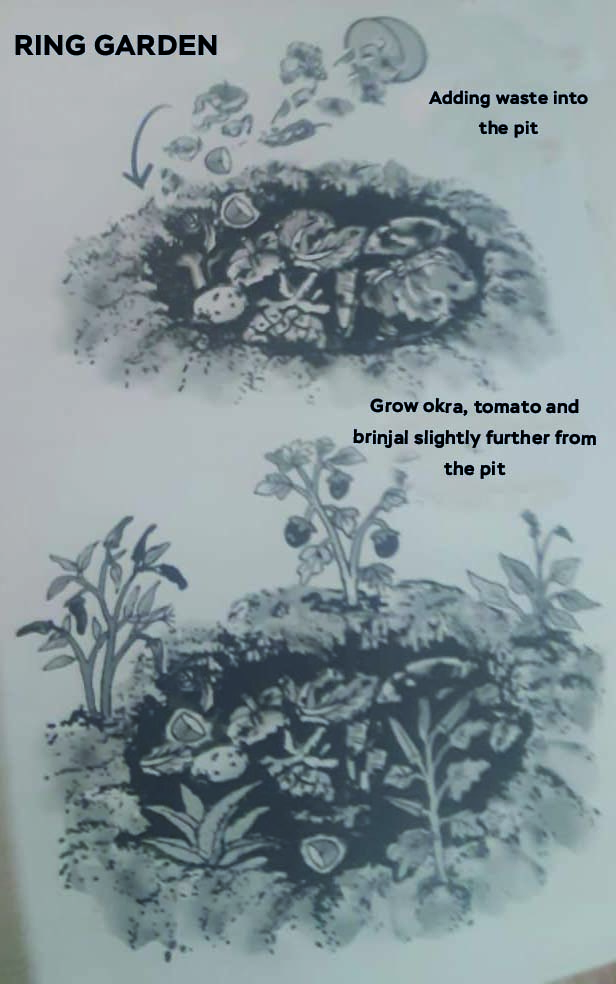
* Mark the soil up to 3 feet diameter and dig the soil in a round shape.
* The depth should be from 1 to one and half feet in the centre and should taper towards the sides like a frying pot.
* Place the dug soil around the periphery of the pit.
* Put kitchen waste in the pit. If cow dung is available add that too in the pit. Sprinkle water in the waste. See pictures)
* Keep repeating this for the next 15 days.
- Start growing vegetables around the periphery of the pit. Grow mint, pennywort and other small vegetables all around the soil near to the pit followed by okra, tomato and brinjal slightly further from the pit. The plants absorb nutrients from the pit and grow well.
c) Double digging garden
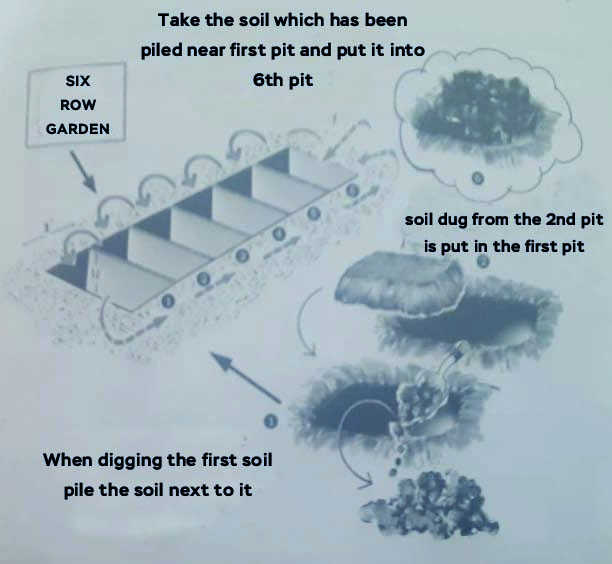
* Select an area 6×4 feet.
* Mark a number for every one foot from 1 to 6. For every one foot leave some space about 3 to 4 inches.
* At the spot marked No 1, dig the soil up to 1 foot depth and pile the soil next to the pit. Then dig the same pit for another 1 foot to loosen the soil. Do not remove this soil, just loosen it.
* Dig the soil at the spot marked No 2 up to 1 foot depth. Put the sol dug from the 2nd pit into the first pit. Then dig the same soil for another 1 foot to loosen it.
* Do the same for spots market No 3, 4 and 5. When digging spot marked No. 6, take the soil which has been piled near pit No.1 and put it into pit No. 6.
* Mix compost in each pit and grow vegetables of your preference.
d) Apartment garden
* Pot – vegetables can be grown in pots. Choose pots which are not heavy. You can hang some of the pots in your balcony and place some on the floor depending on the size of your balcony. Make sure the location you place the pot get enough sunlight.
* Recycle containers – plants can also be grown on recyclable water bottle, biscuit tins and gunny sack. Except for gunny sack, for other containers make a hole at the bottom of the containers. Since gunnysack has tiny holes, there is no need to make holes. When containers are ready, mix garden soil with compost and plant the vegetables.
e) Pipe plants
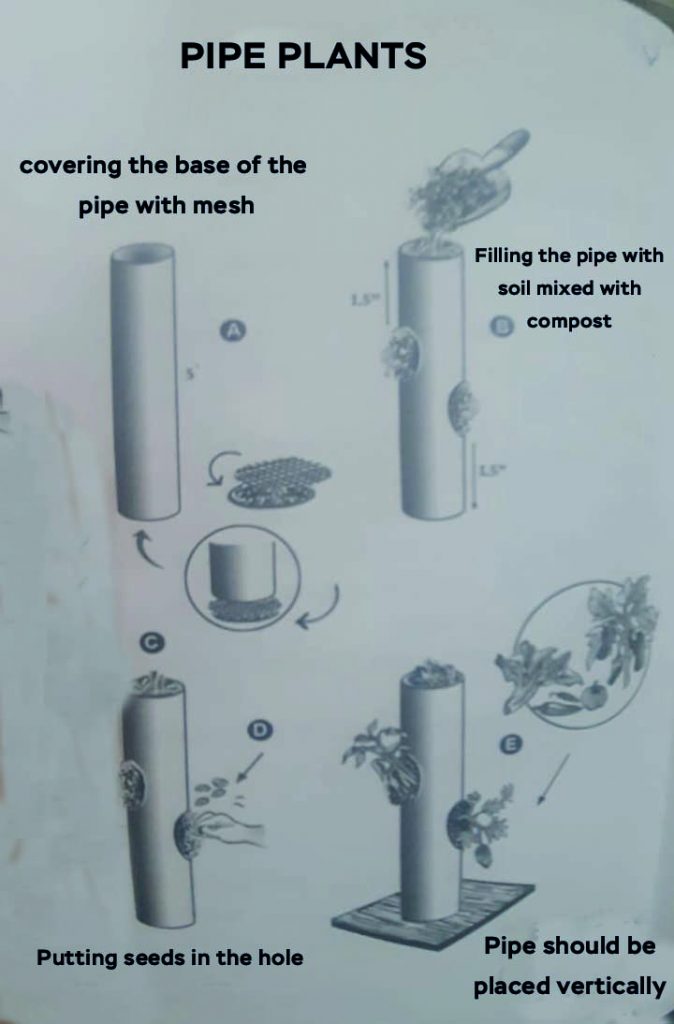
* Select a pipe about 4 to 5 feet length. The mouth of the pipe should be from 3 to 5 inches in diameter.
* If the base of the pipe is closed, then make a hole. If it is opened, cover the base with mesh to prevent the soil from dropping.
* Fill the pipe with garden soil mixed with compost.
* Fill the pipe with garden soil mixed with compost.
* Make a hole on both side of the pipe for every one and half feet as shown in the picture. The diameter of the hole should be less than three quarter inch. Place a seed in this hole. It is enough to put one seed in each hole.
* Place the pipe vertically.
* Apply compost and water the plant in the opening of the pipe.
* Grow vegetables like brinjal, tomato and okra in pipes with the width of 4 to 5 inches in diameter.
f) Hanging plants
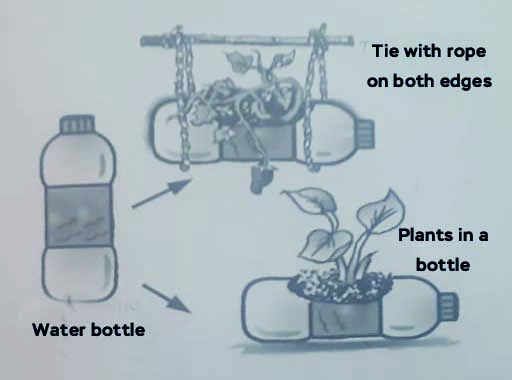
* Cut the centre part of the water bottle as shown in the picture. Add garden soil with compost and grow your vegetables. Plant vegetables with small roots like coriander, mint and pennywort.
* Tie edges of the bottle with a string and hang it.
* Pipes too can be used for this purpose.
- PEST AND DISEASE CONTROL
- It is natural for pests to attack your plants. Plants are also prone to diseases.
- This problem can be easily tackled by preparing simple pest repellents t home.
- Garlic, ginger, pepper, chilli that we use in the kitchen are handy in repelling pests.
- When plants are attacked by pests and worms, take 10 grams of one or two of the above mentioned items. Grind and add 1 litre of water and spray to plants. The pests hide beneath the leaves. Therefore spray the liquid on both sides of the leaves. If the liquid is strong then the leaves may turn brown, so try on a few leaves for a day or two then spray on all plants.
- If ash is available, blow a little on the plant. This gives essential elements to the plants; and also controls some pests.
- SEED TREATMENT
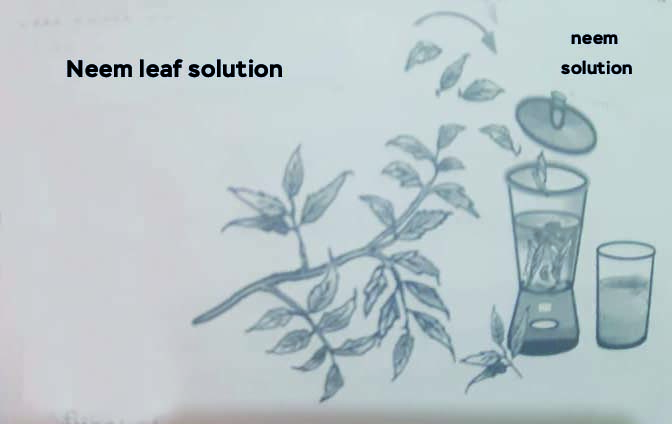
Seeds we use may be attacked by fungus, bacteria or virus. Plants grown with these seeds are susceptible to diseases. Treating the seed is important to avoid this. Soak the seeds in neem leaf solution or acorus solution or cow’s urine, 20 minutes before sowing.
Neem leaf solution
Crush or blend the neem leaf and squeeze 50 ml of juice. Add 100ml of water in this juice, mix well and soak the seeds for 20 minutes before planting.
Acorus solution
Soak 50 grams of acorus n 100ml of water overnight. The next day remove acorus from the ater. Soak the seeds in this water for 20 minutes before planting.
Cow’s urine
If cow’s urine is available, mix 50 ml of cow’s urine in 100n ml of water an soak the seeds in this solution before planting.
- GROWING PLANTS – POINTS TO NOTICE
- It is important to occasionally dig and mix the soil in your bed or pot. Turn the soil carefully so as not to damage the roots. Remove weeds.
- Apply compost to your plants once a fortnight.
- Water drained out while washing rice and fish, can be poured to your plants. However, at times this water may emit foul smell and can attract flies and ants. So do it carefully.
- When adding soil in pot, it should be half portion of garden soil. Another half portion should preferably be equal mixture of sand, red soil and compost.
- Sand is added for aeration. Red sol helps in root fixation. Compost is added for the nourishment of the plant. Mix these well before planting. O nourish the plant with calcium, add crushed egg shell in each pot.
- After one season of planting, empty the pot, mix the soil with compost and fill the pot again for next planting. It is good to change the soil in the pot once a year.
- Do not grow same vegetable in same pot again. For example, if previously okra was planted, this time replace it with brinjal, tomato or any other vegetable.
- After sowing the seeds, use water-can to water the plant. Direct and harsh watering will make the seeds surface and weakens its germination capacity. In the beginning stage, use only water-can to water the plants.
- METHODS OF PLANTING VEGETABLES
Okra
- Okra needs full sunlight.
- Mix soil and compost together in the pot.
- Okra seeds can be sown directly in the pot. If bed method is used, space out 2 feet between each plant. For medium size of pot one okra plant is sufficient.
- Okra grows from 4 to 7 feet in height. The growth differs depending on the quality of the seeds sown, compost used and care taken.
- Okra starts fruiting in 2 months. Okra yields fruits for about 3 months. After this you have to plant fresh seeds.
Radish
- Radish needs ample sunlight.
- Radish belongs to root vegetables. Dig soil up to 2 feet and mix with compost. The soil should be crumbly. Only then the radish could penetrate and grow well.
- Sow radish seeds directly in the soil. Leave 1 feet of space between each plant.
- Radish can be harvested one and half months after planting.
- Make sure water is not stagnant in the soil. This may lead to rotting of the roots.
Brinjal (egg plant)
- Brinjal needs ample sunlight for proper growth.
- Mix compost with soil.
- Sow the seeds for seedling. Transfer the seedlings within 20 to 30 days of sowing.
- Brinjal plant bearts fruit after one and half months of transplanting.
- Two to 3 months after bearing fruit, prune the birnjal plant ans spray fish amino acid . New shoots come out after spraying and start bearing fruit.
- Brinjal plants grow up to 3 feet anda bear fruit for 4 to 5 months.
Chilli
- Chilli needs ample sunlight.
- Prepare soil by adding compost.
- Sow the seeds. Saplings should be transferred within 20 to 30 days of planting. (Chilli seeds are easily attacked by virus. Hence it has to go through seed treatment process.)
- If bed is used, leave two and half feet of space between each plant. If pot is used, one plant is enough for one big pot.
- Chilli gives yield after 30 days of transplanting.
- It fruits for 4 to 5 months.
- Chilli plants grow up to 3 feet.
- METHODS OF PLANTIGN LEAFY VEGETABLES
Kangkung
- Kangkung needs lots of sunlight. Mix compost ot soil and prepare bed.
- In a bed with 1 foot of width, draw a line between every 4 inches. Spread kangkung seeds in each line.
- After dspreading the seeds, clost it by spreading some soil on it.
- Kangkung needs a lot of moisture for proper growth.
- Kangkung can be harvested one month after planting.
Amaranth
- Amaranth needs sunlight for proper growth. Add compost or FEM to the soil.
- In a bed with 1 foot of width, draw a line between every 4 inches. Sspread amaranth seeds in eadh line.
- Since the seeds of amaranth are very tiny, ,mix with sand before spreading.
- Amaranth can be harvested after one month of planting.
Kailan
- Kailan needs sunlight. To prepare the bed, mix compost in the soil.
- Sow the seeds. Afer 20 days , transfer the saplings to the bed. If pot is used, one or two plant is enough for each pot.
- After harvesting, the plants give new shoots for the second time.
- Some like to eat kalian young. Some prefer matured plants. So, harvest according ot your need and taste.
Mint
- Mint needs ample sunlight. Select mint stem with 4 to 5 inch inches length. Plant with space of 3 inches between each stem.
- New shoots come out after each pruning.
Pennywort
- Pennywort grows in soil with good moisture. Ample sunlight is also needed for this.
- Plant the roots of the pennywort with 3 inches of space between each root. Pennywort can also be planted in a wide pot.
- Pennywort gives new shoots after each trimming.
Spring onion
- Spring onions need sunlight.
- Plant the onion with 2 inches of space between each onion. Spring onion is ready for trimming after 2 weeks of planting.
- Spring onion gives new shoots after trimming and this can be harvested again. This can be done for at least 3 times.
- Spring onion can also be planted in pots.
- Garlic too can be planted in the same way and the shoots can be used in cooking.
(Box at begging of page somewhere)
(QUOTE)
“When it is understood that one loses joy and happiness in the attempt to possess them, the essence of natural farming will be realized. The ultimate goal of farming is not the growing of crops, but the cultivation and perfection of human beings.”–Masanobu Fukuoka, The One-Straw Revolution
